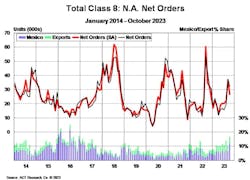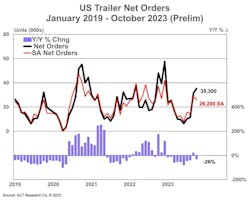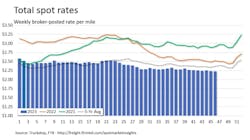Class 8 orders and spot rates: Early data is showing a dim end to 2023
Production slots opened last month, bringing in the best Class 8 order numbers of 2023. Orders are up, and the holiday season is fast approaching, so industry analysts predict economic improvements in trucking. However, recent data from FTR and ACT Research doesn't look as optimistic.
Truck orders in October dropped from September, as anticipated by FTR Transportation Intelligence. Preliminary order numbers for October were down 10% from September and 35% from this time last year, according to FTR.
"We expected a year-over-year decrease in orders and were not surprised by the month-over-month easing, either," said Eric Starks, FTR chairman of the board.
All but 22,000 of the past year's Class 8 orders took place within the last six months—233,000 of 255,000. The annualized rate over the past three months has been much stronger than the 12-month total, but FTR stated it is just a result of 2024 production slots opening.
Another transportation research group, ACT Research, deduced that October Class 8 orders were down 24% from October 2022.
“Final Class 8 net orders were 32,287 units in October, with the largest drivers of orders being market segments with lingering pent-up demand,” Kenny Vieth, ACT’s president and senior analyst, stated.
ACT broke down the segments, reporting that vocational straight truck orders rose 24% year over year, and export market orders were up 91% year over year. Additionally, orders for trucks headed to Mexico saw an increase of 187% year over year, while orders for trucks headed to the U.S. market were down 47% from October 2022.
Build expectations for 2024 remain elevated, according to Vieth, despite supply chain issues that caused a 10% decline in build rates from September to October of this year. As for Class 5-7, pre-strike inventories remain elevated as “medium-duty bodybuilders’ labor challenges persist,” Vieth said.
See also: Truck order numbers soar in September compared to rest of 2023
Preliminary trailer order numbers
Preliminary net trailer order numbers for October show an increase from September with 35,500 units, according to ACT Research. These numbers are down 26% from last October, and adjusting the numbers for peak order season, the seasonally adjusted order numbers for October rests at 26,200.
“Preliminary net orders at 26,200 seasonally adjusted were about 9% lower sequentially,” said Jennifer McNealy, director of CV market research and publications at ACT Research. “While this certainly continues the positive momentum for the industry that began last month, two months of robust orders does not guarantee the full year. It’s still early in the new year order season to call.”
McNealy said cancellations remain elevated, driven by platform and tank segments, and backlogs remain healthy, particularly for specialty segments.
“The BL/BU [backlog-to-build] ratio was well north of five months in aggregate, with some specialty segments having no available build slots until late in 2024 at the earliest,” she said. “We’ve been hearing that order discussions were occurring, and it looks like quotations continue to convert to ‘booked’ business.”
ACT Research expects trailer backlogs to increase by 7,300 units to about 146,100 units when complete October data are released, McNealy said.
See also: NMFTA demonstrates how hackers can disable trucks and trailers
Freight rates leading into the holidays
Expect the freight market to “continue bouncing along the bottom” for the rest of the year into 2024, concluded ACT Research after releasing its “Freight Forecast, U.S. Rate and Volume Outlook” report.
“For carriers, the long bottom in freight rates continues, with spot rates little changed since April,” Vieth said. “A big driver of rate weakness has been lagged private fleet capacity additions. As for-hire fleets tend to be the first buyers in line, private fleets have been the drivers of Class 8 market strength in 2023, adding equipment at the bottom of the cycle and prolonging the rate pain.”
The upcoming holiday season will make way for the industry to end the year on a “higher note,” however, according to Tim Denoyer, ACT Research’s VP and senior analyst.
Interestingly, FTR and Truckstop’s weekly spot rate report saw a slower start to the holiday season than expected.
Spot rates heading into Thanksgiving lag seasonal expectations. Spot rates “almost always” rise the week before Thanksgiving, according to the FTR and Truckstop weekly spot rate report, but that didn’t happen this year.
“Spot rates barely changed for refrigerated and flatbed, and dry van spot rates declined modestly,” the report stated. “Capacity shortfalls during Thanksgiving week usually mean higher dry van spot rates, but last week’s weakness creates uncertainty.”
Total spot rates were 12% lower than the same week last year and 6% lower than the five-year average. Dry van spot rates fell 3.5 cents to 11% below this week in 2022 and 13.5% below the five-year average. Currently, dry van rates are only 7 cents higher than the recent bottom experienced this past May.
Although reefer spot rates typically see an increase the week before Thanksgiving, they barely changed, falling 10% below the rates from this week last year and almost 8% below the five-year average. Additionally, reefer load volume was down 21% the same week last year and nearly 28% below the five-year average. Finally, flatbed rates saw a slight increase of seven-tenths of a cent, with rates 14% below this time in 2022 and 2% below the five-year average.
The expansion in private fleets has pulled freight from the for-hire market, but Denoyer believes purchasing patterns are changing, and he expects to see the freight cycle propel forward next year.
See also: FMCSA publishes final rule on broker financial responsibility
Spot loads postings are low, Class 8 tractor sales have slowed, and fleets continue exiting the market at a “historically elevated” rate, according to ACT Research. However, the industry continues to add capacity, which has led to little progress in rebalancing capacity. With those factors at play, the “removal of overcapacity is gaining momentum,” ACT reported.
About the Author
Jade Brasher
Senior Editor Jade Brasher has covered vocational trucking and fleets since 2018. A graduate of The University of Alabama with a degree in journalism, Jade enjoys telling stories about the people behind the wheel and the intricate processes of the ever-evolving trucking industry.





